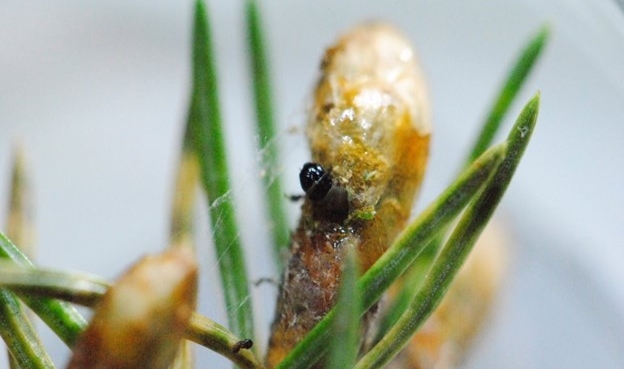Spruce budworms are forest insects that feed on trees and can cause serious damage during outbreaks. Quebec, for instance, has been experiencing a major outbreak for over a decade, with large areas of forest severely affected. When budworms emerge in the spring, young larvae must quickly find food to survive and grow. This study looked at how these larvae decide whether to stay on the tree or move to another one.
Emma Despland, Professor, and Bastien Bellemin-Noël, PhD student in the Department of Biology at Concordia University, led the study along with a member of the Canadian Forest Service, in Fredericton, New-Brunswick. They focused on two common host trees: balsam fir and black spruce. They studied whether the timing of bud opening (called “budburst”) on these trees affects the larvae’s movement. The tiny caterpillars can’t eat the older, tougher needles, so they rely on fresh buds.
Through lab and field experiments, the team found that larvae actively choose to leave trees that don't yet have open buds. The act of leaving—by "ballooning" on silk threads—is a deliberate decision triggered by poor feeding conditions. However, once airborne, the direction the larvae travel is random and wind-driven, making the process risky: larvae might land in unsuitable places like lakes or open ground.
Larvae were more likely to leave black spruce early in the season because its older needles are harder to eat. Balsam fir, even with closed buds, offered some food and protection, so larvae were more likely to stay.
“These early decisions have long-term effects”, explains Despland. “Larvae that leave early may avoid starving, and their choices influence which trees get defoliated. As outbreaks move north and tree bud timing changes with climate, black spruce may become a more common target.”
“Our research shows that even at a very young age, these insects make important choices that affect forest health and the dynamics of insect outbreaks.”


 "As outbreaks move north and tree bud timing changes with climate, black spruce may become a more common target," explains Emma Despland, Professor in the Department of Biology.
"As outbreaks move north and tree bud timing changes with climate, black spruce may become a more common target," explains Emma Despland, Professor in the Department of Biology.